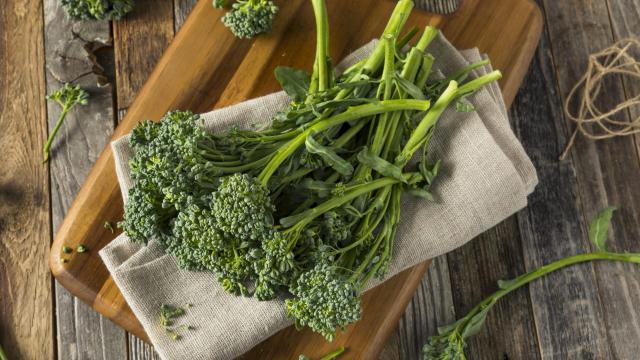Broccoli is a journeyman vegetable. It can be counted on to show up and do its job, and can be great without too much coaxing on your part. Then there are its fancier cousins and friends: broccolini (sometimes called “baby broccoli”), broccoli rabe, and Chinese broccoli.
None of them are baby versions of the short-stalked “standard” broccoli you would find at a cafeteria, and one of them isn’t even in the same genus, but all are delicious in their own right, and worth understanding.
What is broccoli?
You probably already know what broccoli is but just to recap: Broccoli — Brassica oleracea var. italica, if you like biology — is a green edible plant whose short, stocky stalks and fluffy flowering heads are eaten as a vegetable. It’s in the brassica family, along with cruciferous vegetables like cabbage and Brussels sprouts, and it’s pretty good when roasted, lightly steamed, stir fried, or covered in cheese. I like to candy mine in the air fryer, and will sometimes save up the stems to make a cheesy tart.
What is broccolini, and is it really a baby?
Broccolini is often referred to as “baby broccoli” or “uncle baby broccoli” (maybe that’s just in my kitchen), but it is its own thing. The broccolini you buy at the store is fully grown, and will not mature into “regular” broccoli, but it is fair to refer broccolini as the love child of “regular” broccoli and Chinese broccoli, a stalky, leafy green vegetable known as “jie lan” in Mandarin and “gai lan” in Cantonese.
Technically, this vegetable should be called Broccolini®, as it is in fact trademarked. According to MarthaStewart.com, the vegetable was originally developed to be more heat tolerant than broccoli:
In the late 1980s, the idea for a new vegetable was born in Japan. The Sakata Seed Corporation, a leading broccoli seed grower and exporter, wanted a crop with a longer harvest season and that was less fussy about growing conditions, than broccoli (which hates being hot). The result was a cross between two varieties of Brassica oleracea. The first is Brassica oleracea var. alboglabra, or Chinese kale, whose stalks are succulent and very leafy, with diminutive, loose florets. It’s relatively heat-tolerant. The second is familiar old broccoli, Brassica oleracea var. italica, with stout, tougher stalks and enormous, tight heads. After years of experiments, a hand-pollinated hybrid was named “Asparation” because of its tenderly asparagus-like stems.
“Asparation” was a little too cerebral to catch on, and was eventually replaced with the cuter, catchier “broccolini.” The trademark doesn’t affect the life of the average vegetable eater, but it can make finding broccolini seeds a little bit difficult, unless you know to look for non-trademarked names like “tender stem broccoli,” “mini broccoli,” or “sprouting broccoli.”
Flavour-wise, broccolini is a little sweeter than broccoli, with notes of asparagus. Its long, elegant-looking, tender stems that have just the right amount of crunch, and quick steam or sauté is all you need to render the vegetable tender-crisp. Finish with a drizzle of tasty fat — such as olive oil, pistachio oil, or sesame oil — and you have a delicious and nutritious side in a matter of minutes.
What is Chinese broccoli?
As we briefly discussed just a few paragraphs ago, jie lan is leafier than broccoli, with thick, sumptuous stems and tiny flowering heads. It has a strong broccoli-like flavour that is a touch more bitter than its fluffy cousin. You can also find young Chinese broccoli at most Asian supermarkets, which will be a little leafier, with fewer florets and a more tender stem. If you’ve never cooked with Chinese broccoli before, a simple stir fry that highlights the vegetable is the best way to start; much like broccolini, they also take well to a steam, followed by a drizzle of fat. (Just make sure to trim off any tough ends, just like you would with asparagus or…broccoli.)
Broccoli rabe isn’t broccoli
Broccoli rabe — aka “rapini” — sure looks a whole lot like extra-leafy broccolini, but it’s actually more closely related to the turnip. The stems are a bit more bitter than either broccoli or broccolini, with nutty little flower buds that pair well with provolone. Much like every other vegetable with “broccoli” in its name, it takes well to a medium-heat sauté, a steam, or a roast. No matter what method you choose, cook the vegetable to the point of bright green tender-crispness, or get it nice and crispy. (I personally love roasting it until it gets a little charred, then covering it with a cloud of Parmigiano-Reggiano.)

Leave a Reply
You must be logged in to post a comment.